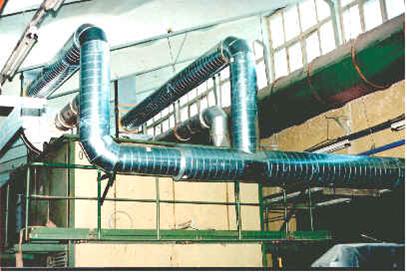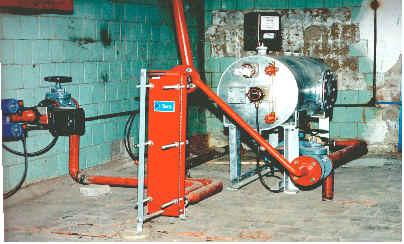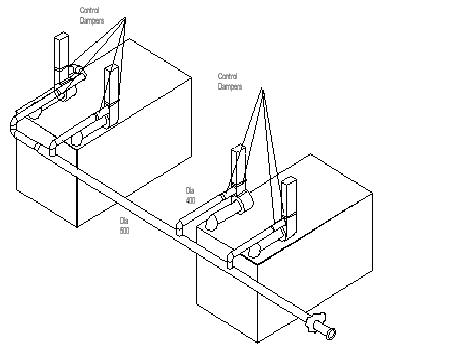Heat recovery from drying (Mongolia)
Back to EFFICIENCY FINDER
Back to Information about cotton and bast fibres
Back to the Case studies
- 1. Case study or Built example
Case study
- 2. Industry Sector
Washing and drying of woven fabric.
- 3. Industrial application
Heat recovery system from a drying process in a textile factory.
- 4. Process description
- Flowsheet
No information is available.
- Processes
Mongol Nekhmel processes wool which includes washing woven fabric followed by drying in stenter dryers. Imported steam provides the heat for the washing and drying machines. Condensate, still containing high levels of energy, is returned to the power station. Hot air exhausted from the dryers is discharged to outside.
The factory comprises a textile processing plant. Woven fabrics are washed in drum washing machines. Hot water is pre-heated in steam heated storage tanks and fed to the machines. Steam injection is used to bring it up to working temperature. After washing, the fabrics are dried in one of two stenter drying machines, with steam heated drums. Forced ventilation takes in ambient air and heats it with steam coils. The hot exhaust air is discharged to outside by extract fans.
- 5. Energy flows and temperature ranges
- Main heat supply system and fuel:
No information is available.
- Energy consumption:
No information is available:
- Temperature ranges and other parameters:
No information is available.
- 6. New technology’s description
- Picture of the scheme
- Description
Significant energy savings are possible by the installation of a plate heat exchanger in the condensate return. This allows the remaining energy in the condensate to be recovered and used to pre-heat cold wash water. The installation of a passive ducting system to divert dryer exhaust air for use in space heating in an adjacent area further increases energy efficiency.
By-pass pipework has been installed on the condensate main, to divert it to a plate heat exchanger and recover remaining energy in the condensate. The secondary side of the exchanger is connected to the existing cold water supply which is pre-heated in the heat exchanger and pumped into the existing hot water storage tank. Since the flow of condensate will be non-continuous, it is first collected in a small holding tank before being pumped through the exchanger. To avoid cold water being pumped when no condensate is available, the cold water pumps and condensate pumps have been interlocked together.
Fig. 2 Heat exchanger
New ducting has been installed which can divert the hot dryer exhaust air through a filter into an adjacent workshop area. A manual by-pass for summer operation is incorporated. This exhaust air is very moist, which under most circumstances would be problematical. In this case, however, this moisture can be utilised to good effect, since a high humidity benefits the spinning process, and the ambient humidity during the severe Mongolian winters is very low.
Fig 3. Schematic of heat recovery ducting
A new fiscal meter has been installed in the incoming steam main. This allows more accurate monitoring of site steam consumption and will improve energy efficiency awareness.
- 7. Energy savings
- Pinch analysis results
No information is available.
- Energy savings:
The project installation was completed in December 1999.At this time, due to a lull in production, the factory had been shutdown, and the steam and water supplies isolated. For this reason it was not possible to fully commission the equipment, nor to run the associated factory plant in order to evaluate the actual savings. Savings have been estimated by calculation. Heat recovered from the condensate, assuming 3600 hours p.a. operation yields an annual saving of 500,400 kWh. This equates to an annual cost saving of USD 5,145, (MNT 5,504,000). The conditions of the dryer exhaust air indicates that 675 kW will be recoverable for use as space heating. Used for 1440 hrs per annum, this would yield a saving of 972,000 kWh The cost of the equivalent imported heat would be USD 9,990 (MNT 10,692,000) per annum. The total, net cost saving is estimated to be USD 15,135 (MNT 16,196,400) p.a. The payback period is 1.9 years.
- 8. Economic evaluation
- Economic parameters:
The costs of the installed equipment are summarised below:
This cost excludes installation, which was performed by the plant staff, and commissioning, which was carried out by the Consultant. For the purposes of the project, all equipment, including ancillaries, was imported from the EU and was exempt from Mongolian import duty. For evaluation purposes, the cost of freight from the EU was excluded.
Site personnel have showed great interest in the plant and equipment. As it has not been possible to commission the plant fully, they are approaching it’s operation with some caution. Nonetheless, they have acquired through the installation a good understanding of the principles involved. They appreciate the value of the potential savings and consequently are very enthusiastic about implementing the project.
Source: Nifes Consulting Group Charringtons House North, The Causeway, Bishop's Stortford Hertfordshire, UK
Back to EFFICIENCY FINDER
Back to Information about cotton and bast fibres
Back to the Case studies




